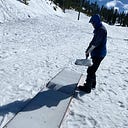Overcoming Flatland Challenges: Techniques for Snowboarding on Low-Incline Terrain
Snowboarding on flat terrain, often called “flatland,” can be frustrating, especially if you’re used to the adrenaline of steep descents. However, flatland sections are an unavoidable part of many mountain runs, whether you’re navigating trails between slopes or heading back to the lift. Learning techniques to handle these stretches effectively can help you conserve energy and maintain momentum, making your day on the mountain much more enjoyable.
Why Flatland Can Be Tricky
Flat terrain poses unique challenges for snowboarders due to the lack of gravitational pull that makes downhill riding effortless. Here are some common difficulties:
- Momentum Loss: Without a slope, maintaining speed becomes challenging.
- Edge Catching: On flat ground, edges can dig into the snow unexpectedly, causing instability.
- Fatigue: Pushing with one foot or walking in snowboard boots can be exhausting and disrupt the flow of your ride.
Fortunately, with a few strategic adjustments, you can turn flatland into a manageable, even enjoyable, part of your snowboarding experience.
Techniques for Flatland Snowboarding
1. Keep Your Speed Up
The best way to tackle flatland is to enter it with sufficient speed. Before reaching the flat section:
- Straighten Your Path: Avoid unnecessary turns that reduce momentum.
- Tuck Your Body: Bend your knees, keep your arms close, and lower your torso to reduce wind resistance.
2. Master the Glide
Once on flat terrain, maintaining balance and a steady glide is crucial:
- Weight Distribution: Center your weight evenly over the board. Leaning too far forward or backward can slow you down or cause a wobble.
- Flat Base Riding: Keep your snowboard flat against the snow. Engaging edges can cause unnecessary drag or an edge catch.
3. Use the Skate Push
When momentum runs out, you’ll need to rely on the skate push technique:
- Unstrap Your Back Foot: Remove your back foot from the binding and place it on the stomp pad or snow.
- Push Off Like a Skateboard: Use your back foot to push forward in short, controlled motions. Avoid overextending, as it can throw off your balance.
4. Utilize Small Turns
If you’re on a very slight incline, you can use gentle turns to generate speed:
- Side-to-Side Motion: Shift your weight to the toeside and heelside edges alternately. This technique creates a “pumping” effect that propels you forward.
Gear Tips for Flatland Riding
Certain snowboard setups can help you handle flat terrain more effectively:
- Wax Your Board: Regular waxing reduces friction and helps your board glide more smoothly.
- Choose the Right Board: Boards with a flat or rocker profile are less likely to catch an edge, making them more forgiving on flat sections.
- Install a Stomp Pad: A textured pad near the rear binding provides grip for your back foot during skate pushing.
Mindset Matters
Patience and practice are key to mastering flatland snowboarding. Viewing flat sections as an opportunity to refine your balance and control can turn them from a nuisance into a skill-building exercise.
Final Thoughts
Snowboarding on flatland terrain doesn’t have to ruin your run. By applying techniques like maintaining speed, practicing flat base riding, and mastering the skate push, you can navigate these sections with confidence and efficiency. Embrace the challenge, and you’ll find that flatland riding is just another way to enhance your versatility on the slopes.
Originally posted on http://shawnboday.net/
